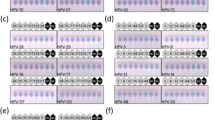Abstract
Electron microscopic in situ hybridization (EMISH) of common warts (verrucae vulgares) of the hands was performed using a biotinylated human papillomavirus type 2a (HPV-2a) DNA probe and immunogold labelling of ultrathin sections of 2% glutaraldehyde-fixed, Lowicryl K4M-embedded tissues. It was first established that the warts contained HPV-2a DNA by light microscopic in situ hybridization. The HPV-2a probe chiefly labelled cells in the horny, granular and upper spinous layers of the epidermis, and labelling decreased towards the basal cell layer. The gold particles were located precisely on the viral particles in the nuclei of granular cells. The lower limit of detection by EMISH was found to be the keratinocytes of the third cellular layer above the basal cells. These keratinocytes showed evidence of a viral cytopathic effect, suggesting that vegetative DNA replication in infected keratinocytes occurs at least as early as this level of the epidermis.
Similar content being viewed by others
References
Binder M, Tourmente S, Roth J, Renaud M, Gehring WJ (1986) In situ hybridization at the electron microscope level: localization of transcripts on ultrathin sections of Lowicryl K4M-embedded tissue using biotinylated probes and protein A-gold complexes. J Cell Biol 102: 1646–1653
Buongiorno-Nardelli M, Amaldi F (1969) Autoradiographic detection of molecular hybrids between rRNA and DNA in tissue sections. Nature 225: 946–947
Burns J, Graham AK, Frank C, Fleming KA, Evans MF, McGee JO'D (1987) Detection of low copy human papilloma virus DNA and mRNA in routine paraffin sections of cervix by non-isotopic in situ hybridisation. J Clin Pathol 40: 858–864
Croissant O, Breitburd F, Orth G (1985) Specificity of cytopathic effect of cutaneous human papillomaviruses. Clin Dermatol 3: 43–55
Gall G, Pardue ML (1969) Formation and detection of RNA-DNA hybrid molecules in cytological preparations. Proc Natl Acad Sci USA 63: 378–381
Heilman CA, Law MF, Israel MA, Howley PM (1980) Cloning of human papillomavirus genomic DNAs and analysis of homologous polynucleotide sequences. J Virol 36: 395–407
Howley PM (1990) Papillomavirinae and their replication. In: Fields BN, Knipe DM, Chanock RM, Hirsch MS, Melnick JL, Monath TP, Roizman B (eds.) Virology. Raven Press, New York, pp 1625–1650
Hutchison NJ, Langer-Safer PR, Ward DC, Hamkalo BA (1982) In situ hybridization at the electron microscopic level: hybrid detection by autoradiography and colloidal gold. J Cell Biol 95: 609–618
John HL, Birnstiel ML, Jones KW (1969) RNA-DNA hybrids at the cytological level. Nature 223: 912–913
Puvion-Dutilleul F, Puvion E (1989) Ultrastructural localization of viral DNA in thin sections of herpes simplex virus type 1 infected cells by in situ hybridization. Eur J Cell Biol 49: 99–109
Roth J, Bendayan M, Carlemalm E, Villiger W, Garavito M (1981) Enhancement of structural preservation and immunocytochemical staining in low temperature embedded pancreatic tissue. J Histochem Cytochem 29: 663–671
Sambrook J, Fritsch EF, Maniatis T (1989) Molecular cloning: a laboratory manual. Cold Spring Harbor Laboratory Press, Cold Spring Harbor, New York
Syrjanen S, Partanen P, Mantyjarvi R, Syrjanen K (1988) Sensitivity of in situ hybridization techniques using biotin and 35S labelled human papillomavirus (HPV) DNA probes. J Virol Methods 19: 225–238
Wolber RA, Beals TF, Lloyd RV, Maassab HF (1988) Ultrastructural localization of viral nucleic acid by in situ hybridization. Lab Invest 59: 144–151
Author information
Authors and Affiliations
Rights and permissions
About this article
Cite this article
Hagari, Y., Shibata, M., Mihara, M. et al. Detection of human papillomavirus type 2a DNA in verrucae vulgares by electron microscopic in situ hybridization. Arch Dermatol Res 285, 255–260 (1993). https://doi.org/10.1007/BF00371593
Received:
Issue Date:
DOI: https://doi.org/10.1007/BF00371593




